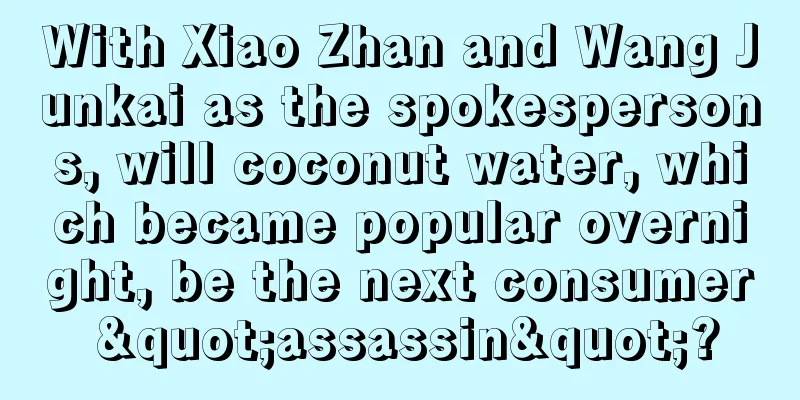How did coffee start to develop in strange directions?

Conventional innovation can no longer satisfy this generation of coffee brands. 01 Coffee is getting weirder"Can coffee" has become popular in the county, with daily sales of more than 30,000. The owner makes coffee in the store according to the order, preserves it in vacuum cans, and packs it with ice to ship the freshly made coffee to the whole country via SF Express cold chain; "temple coffee" has become popular in the city. Taizhou Longxing Temple, Xiamen Nanputuo Temple, Shanghai Jade Buddha Temple, Hangzhou Yongfu Temple and many other temples have opened coffee shops in the past year, attracting many young people to check in. Coffee is beginning to develop in increasingly strange directions. In fact, this strangeness is not only reflected in the model, but also in the packaging, taste and price. First of all, the packaging. Saynice's capsule coffee has attracted the attention of many young people on social networking sites. A capsule machine has 24 coffee balls of different flavors. When you twist it, a blind box coffee capsule will fall out. The coffee chain brand DEAR BOX blind box coffee also recently completed its A+ round of financing. It adopts a design similar to a game console. The door only retains a machine that displays blind boxes and an order window. Consumers cannot specify specific products when ordering, but can only choose the temperature (hot/ice) and category (coffee/tea/any). After the production is completed, you need to press the button on the blind box machine to pick up the food. The second is taste. Last year, Tai Er Pickled Cabbage Fish launched four kinds of freshly brewed coffee: pickled cabbage latte, tangerine peel cold brew, pepper Americano and chrysanthemum lemon coffee, as well as a tangerine peel flavored pickled cabbage fish drip coffee; SeeSaw previously launched century egg coffee; in addition, many exotic flavors have appeared on the market, such as spicy coffee and tofu brain coffee. Finally, the price. In February this year, the tea brand CoCo announced that the price of freshly ground American coffee was reduced to 3.9 yuan per cup, and the price of raw coconut latte was reduced to 8.9 yuan per cup. After the price reduction, the price of a single cup of American coffee was 1.1 yuan lower than that of Mixue Bingcheng. Coodi Coffee, which was re-founded by the founder of Luckin Coffee, is priced at 9.9 yuan per cup for American coffee and 11.9 yuan per cup for raw coconut latte, which are highly overlapped with Luckin's products, but the price is generally about 3 yuan lower than Luckin. Earlier, when Starbucks maintained its leading position in the domestic coffee market at 30 yuan per cup, Luckin Coffee lowered the price of a cup of coffee to less than 20 yuan. It is worth noting that while coffee prices have broken through the bottom line again and again, the price of coffee beans has become higher and higher. On February 24, Yunnan coffee beans were sold at 37.81 yuan/kg. Nestle's price in Yunnan has never been lower than 35 yuan/kg since February 10, which has set a new high for coffee beans in 10 years. According to LatePost, even with the repeated increase in the price, Nestle has not been able to purchase enough beans in Yunnan. As for Starbucks, due to the inverted price, it has basically not purchased Yunnan beans this year. Sun Kai, vice president of Tiantu Ventures in charge of the food and beverage track, publicly stated some time ago that after years of market innovation of brands and products, consumers have a more comprehensive understanding of coffee beans, roasting, and brewing methods, and have gradually formed their own preferences. Consumers have gone from liking the flavor of coffee to understanding coffee itself, which shows that their understanding of coffee has reached a new level, and consumers have higher expectations for better-tasting and higher-quality products. But it is worth noting that the coffee products that have become popular recently, whether it is "can coffee", "temple coffee", "capsule coffee machine", or "coffee blind box", are essentially innovations in coffee packaging. 02Why is coffee getting weirder?In fact, high-quality coffee beans, regional flavors, and roasting techniques are the core of a cup of coffee. Although exotic coffee can often attract consumers' attention at the first time, novelty alone is often not enough to retain consumers for a long time. In Yilan Business’s view, coffee is now more popular through packaging, co-branding, low prices, and exotic flavors, rather than coffee flavors and brewing methods. There are two main reasons for this: On the one hand, from the perspective of the industry, the market is gradually maturing and competition is becoming more and more normalized. For coffee brands of all sizes on the market, it is very likely that they all purchase coffee beans from the same region. It is too difficult for existing coffee brands to stand out by relying on the subtle differences in coffee flavors, and it is not easy to be remembered by the market. However, co-branded, limited, and exotic flavors can attract consumers to check in, gain traffic on social networking sites, make the brand more recognizable and memorable, and low prices can also encourage consumers to consume. Wu Daiqi, CEO of Shenzhen Siqisheng Company, also told Yilan Business that a certain market structure has been formed through brand segmentation, and it is difficult for new entrants to make innovative breakthroughs in such a classification, so they can only innovate at the marketing level. In addition, this also reflects to a certain extent that these companies may be catering to the preferences of young users today. On the other hand, from the perspective of consumers, young consumers are more likely to be attracted by appearance and unique packaging. They may not be able to distinguish the subtle differences between coffee beans from different origins and different degrees of roasting. But they can feel the fashion and personality reflected in the outer packaging and are willing to pay for special designs and unique printing. Innovation in packaging and form is the innovation method with the lowest technical cost. Ou Feng, founder of the Military Advisor Think Tank Catering Research Institute, once pointed out that a large number of coffee shops sell "coffee-flavored beverages" and the popularity of Chinese people's coffee drinking habits is more about the popularity of coffee-flavored beverages as an addiction. Traditional coffee and specialty coffee can only remain in a small number of coffee lovers and sentimental coffee shops that cannot form a large chain. Overall, competition in the coffee industry has become a red ocean. Nowadays, coffee chains in the market have launched a variety of ways to attract consumers, such as co-branded, limited edition, and exotic flavors. These are just ways for companies to find new opportunities. After all, every company wants to capture young consumers in this era. But when price wars are endless, joint marketing is involution, flavors are constantly novel, and consumers are attracted by one fresh product after another, how long can external packaging and marketing alone attract consumers? 03 It is difficult to build a brand moat by seeking noveltyPerfect Diary has answered this question based on its own experience. After achieving a comprehensive breakthrough in the brand through the control of traffic, marketing, celebrity endorsements, and KOL promotion, Perfect Diary's parent company Yatsen E-Commerce went public on November 19, 2020. The company's market value soared all the way, once exceeding US$16 billion. As of press time, Yatsen E-Commerce's market value is less than US$1 billion. In the past, during the bonus period of traffic, a wave of consumer brands that became popular due to traffic were collected. But when the bonus period ended, the price for companies to buy traffic became more and more expensive, and this strategy was no longer sustainable. Business competition is like a war without gunpowder. Sometimes, just a difference in thought can determine the life or death of a business. To survive in this war, maintaining a winning posture and building one's own "moat" is a key step. And brand awareness is often this moat. In contrast, most existing coffee brands in China rely on joint marketing and exotic flavors to gain popularity on social networking sites, pursuing short-term marketing effects, and completely separating brands from products. Take seeding and live streaming as examples. Each influencer has his or her own style and discourse system, and adopts a more natural and de-branded description method to stimulate fans' purchasing behavior. Therefore, seeding content often varies greatly, with different focuses, and an influencer will continue to promote various products over a period of time. Whether it is short videos or live streaming, the frequency and time left for a brand are very limited. This is completely contrary to the logic of corporate branding. Brands need to form a consistent memory, often need to extract a unified single symbol, and promote it repeatedly. This also means that it is impossible to form a brand mindset by simply relying on content and influencer promotion. In this process, it often only achieves the effect of selling goods. The result of only pursuing sales is that a company goes through great pains to create a hit product, but competitors can easily launch the same or similar products, leading to homogeneous competition, and can only engage in price wars or continue to work on marketing. Coca-Cola's revenue in 2021 was only $38.7 billion, but its brand value is $57.5 billion. Robert Woodruff, former chairman of Coca-Cola, once said, "If my factory burned down overnight, as long as the Coca-Cola brand was still there, I could make a comeback the next day." In comparison, the moat of domestic coffee brands is not deep. Take Luckin Coffee, which currently has the largest number of stores and the strongest development momentum, as an example. When Kudi Coffee copied Luckin Coffee's development model and lowered the price of Luckin Coffee's star product by about 3 yuan, it snatched away a wave of customers that originally belonged to Luckin Coffee. Obviously, Luckin Coffee needs to further deepen its brand awareness in order to become the final winner in this coffee war. Branding is actually a slow process, but at the same time it is also a fast process in the long run. It is slow in that it takes a long time to accumulate every bit of trust; it is fast in that it creates shortcuts and becomes the choice of users without hesitation. This is true not only for the coffee market, but also for fast-moving consumer goods. What we should pursue is not only the conversion rate of a single marketing campaign, nor the sales volume brought by a single promotion, but also the trust of users, building our own brand moat, and making ourselves the first choice of users without hesitation. Author: Cheng Rumeng Source: WeChat public account "Yilan Business" |
Recommend
Quickly create a short video account: How to benchmark the account?
This article details four methods on how to find b...
What is the end point of the e-commerce war?
In recent years, the e-commerce industry has matur...
Xiaohongshu Hot Article Secrets [April]
In the commercial launch of Xiaohongshu, hot artic...
WeChat stores support early distribution of video accounts!
The upgrade of WeChat Stores has brought new distr...
Is it necessary to create a matrix on Xiaohongshu?
In the era of digital marketing, how brands can ef...
I spent 5,000 yuan to buy 20 courses on selling good products on Douyin, but none of them was useful!
The author spent 5,000 yuan to buy more than 20 Do...
Da Bing, who was ridiculed by everyone, counterattacked and became the "intimate uncle" in the live broadcast room?
Da Bing, who was once ridiculed for his unique ide...
How many days can Shopee's vacation mode last? How to enable vacation mode?
Nowadays, many people are engaged in cross-border ...
How to upload a main image video on Amazon? What are the requirements?
Today, I will introduce you to the content of Amaz...
Why are your data review reports always criticized?
Many data analysts often encounter questions from ...
What is Amazon's official customer service phone number? How can I contact Amazon's customer service?
Shopping on Amazon is very good, especially in ter...
Whoever plays with it will become popular! Has playing with memes become a hard currency for brand marketing?
In the tide of Internet culture, meme marketing, w...
In 2024, every business should master this "low-traffic survival technology"
What is "low-traffic survival technology"...
How to calculate Amazon advertising budget? What are the methods?
On the Amazon platform, many people usually do pro...
How does WonderLab establish its dominance in the “meal replacement shake” market with a new product?
When many people didn't know what meal replace...









